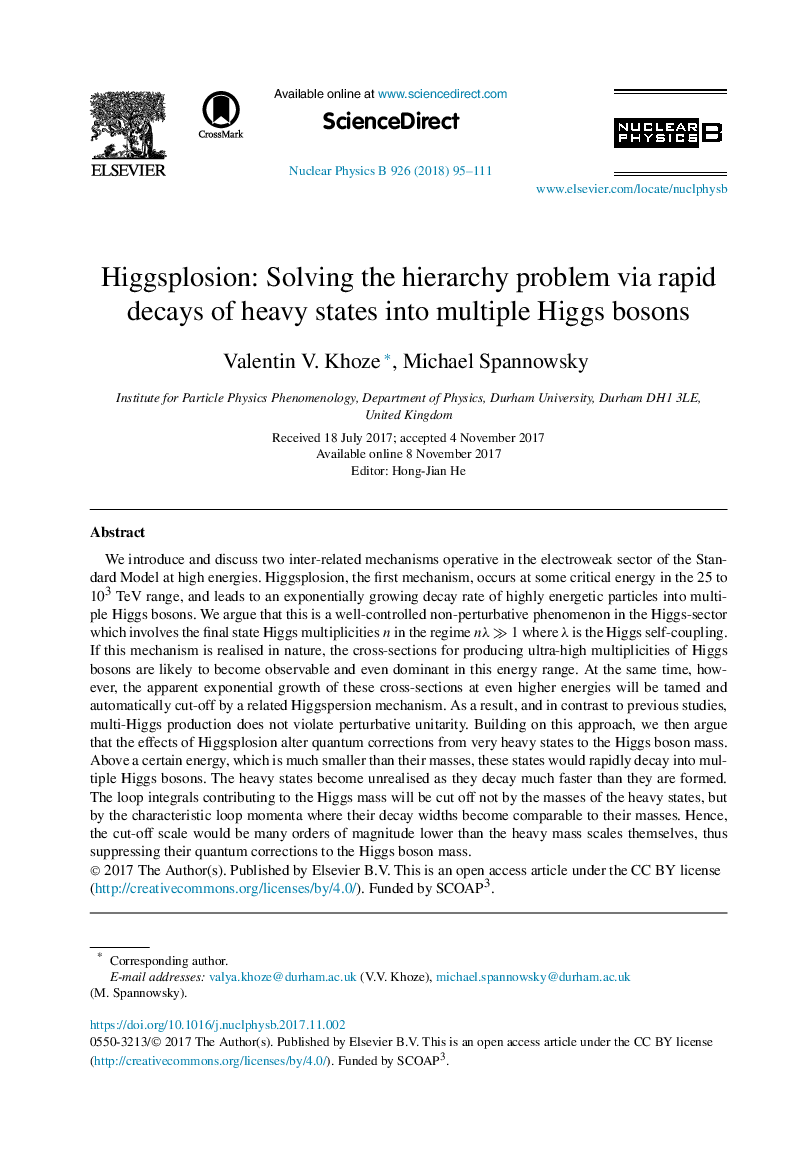| کد مقاله | کد نشریه | سال انتشار | مقاله انگلیسی | نسخه تمام متن |
|---|---|---|---|---|
| 8185043 | 1527697 | 2018 | 17 صفحه PDF | دانلود رایگان |
عنوان انگلیسی مقاله ISI
Higgsplosion: Solving the hierarchy problem via rapid decays of heavy states into multiple Higgs bosons
دانلود مقاله + سفارش ترجمه
دانلود مقاله ISI انگلیسی
رایگان برای ایرانیان
موضوعات مرتبط
مهندسی و علوم پایه
ریاضیات
فیزیک ریاضی
پیش نمایش صفحه اول مقاله

چکیده انگلیسی
We introduce and discuss two inter-related mechanisms operative in the electroweak sector of the Standard Model at high energies. Higgsplosion, the first mechanism, occurs at some critical energy in the 25 to 103TeV range, and leads to an exponentially growing decay rate of highly energetic particles into multiple Higgs bosons. We argue that this is a well-controlled non-perturbative phenomenon in the Higgs-sector which involves the final state Higgs multiplicities n in the regime nλâ«1 where λ is the Higgs self-coupling. If this mechanism is realised in nature, the cross-sections for producing ultra-high multiplicities of Higgs bosons are likely to become observable and even dominant in this energy range. At the same time, however, the apparent exponential growth of these cross-sections at even higher energies will be tamed and automatically cut-off by a related Higgspersion mechanism. As a result, and in contrast to previous studies, multi-Higgs production does not violate perturbative unitarity. Building on this approach, we then argue that the effects of Higgsplosion alter quantum corrections from very heavy states to the Higgs boson mass. Above a certain energy, which is much smaller than their masses, these states would rapidly decay into multiple Higgs bosons. The heavy states become unrealised as they decay much faster than they are formed. The loop integrals contributing to the Higgs mass will be cut off not by the masses of the heavy states, but by the characteristic loop momenta where their decay widths become comparable to their masses. Hence, the cut-off scale would be many orders of magnitude lower than the heavy mass scales themselves, thus suppressing their quantum corrections to the Higgs boson mass.
ناشر
Database: Elsevier - ScienceDirect (ساینس دایرکت)
Journal: Nuclear Physics B - Volume 926, January 2018, Pages 95-111
Journal: Nuclear Physics B - Volume 926, January 2018, Pages 95-111
نویسندگان
Valentin V. Khoze, Michael Spannowsky,